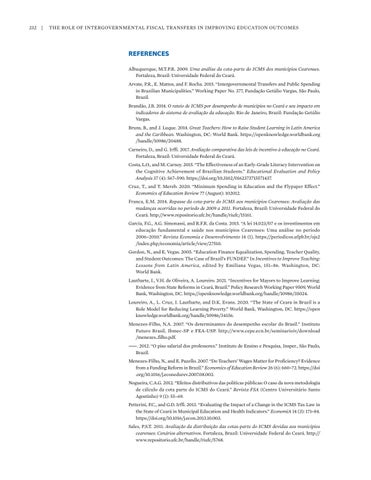232 | The Role of Intergovernmental Fiscal Transfers in Improving Education Outcomes
REFERENCES Albuquerque, M.T.P.R. 2009. Uma análise da cota-parte do ICMS dos municípios Cearenses. Fortaleza, Brazil: Universidade Federal do Ceará. Arvate, P.R., E. Mattos, and F. Rocha. 2015. “Intergovernmental Transfers and Public Spending in Brazilian Municipalities.” Working Paper No. 377, Fundação Getúlio Vargas, São Paulo, Brazil. Brandão, J.B. 2014. O rateio de ICMS por desempenho de municípios no Ceará e seu impacto em indicadores do sistema de avaliação da educação. Rio de Janeiro, Brazil: Fundação Getúlio Vargas. Bruns, B., and J. Luque. 2014. Great Teachers: How to Raise Student Learning in Latin America and the Caribbean. Washington, DC: World Bank. https://openknowledge.worldbank.org /handle/10986/20488. Carneiro, D., and G. Irffi. 2017. Avaliação comparativa das leis de incentivo à educação no Ceará. Fortaleza, Brazil: Universidade Federal do Ceará. Costa, L.O., and M. Carnoy. 2015. “The Effectiveness of an Early-Grade Literacy Intervention on the Cognitive Achievement of Brazilian Students.” Educational Evaluation and Policy Analysis 37 (4): 567–590. https://doi.org/10.3102/0162373715571437. Cruz, T., and T. Mereb. 2020. “Minimum Spending in Education and the Flypaper Effect.” Economics of Education Review 77 (August): 102012. Franca, E.M. 2014. Repasse da cota-parte do ICMS aos municípios Cearenses: Avaliação das mudanças ocorridas no período de 2009 a 2011. Fortaleza, Brazil: Universidade Federal do Ceará. http://www.repositorio.ufc.br/handle/riufc/15161. Garcia, F.G., A.G. Simonassi, and R.F.R. da Costa. 2015. “A lei 14.023/07 e os investimentos em educação fundamental e saúde nos municípios Cearenses: Uma análise no período 2006–2010.” Revista Economia e Desenvolvimento 14 (1). https://periodicos.ufpb.br/ojs2 /index.php/economia/article/view/27510. Gordon, N., and E. Vegas. 2005. “Education Finance Equalization, Spending, Teacher Quality, and Student Outcomes: The Case of Brazil’s FUNDEF.” In Incentives to Improve Teaching: Lessons from Latin America, edited by Emiliana Vegas, 151–86. Washington, DC: World Bank. Lautharte, I., V.H. de Oliveira, A. Loureiro. 2021. “Incentives for Mayors to Improve Learning: Evidence from State Reforms in Ceará, Brazil.” Policy Research Working Paper 9509, World Bank, Washington, DC. https://openknowledge.worldbank.org/handle/10986/35024. Loureiro, A., L. Cruz, I. Lautharte, and D.K. Evans. 2020. “The State of Ceara in Brazil is a Role Model for Reducing Learning Poverty.” World Bank, Washington, DC. https://open knowledge.worldbank.org/handle/10986/34156. Menezes-Filho, N.A. 2007. “Os determinantes do desempenho escolar do Brasil.” Instituto Futuro Brasil, Ibmec-SP e FEA-USP. http://www.cepe.ecn.br/seminarioiv/download /menezes_filho.pdf. ———. 2012. “O piso salarial dos professores.” Instituto de Ensino e Pesquisa, Insper., São Paulo, Brazil. Menezes-Filho, N., and E. Pazello. 2007. “Do Teachers’ Wages Matter for Proficiency? Evidence from a Funding Reform in Brazil.” Economics of Education Review 26 (6): 660–72. https://doi .org/10.1016/j.econedurev.2007.08.003. Nogueira, C.A.G. 2012. “Efeitos distributivos das políticas públicas: O caso da nova metodologia de cálculo da cota parte do ICMS do Ceará.” Revista FSA (Centro Universitário Santo Agostinho) 9 (1): 55–69. Petterini, F.C., and G.D. Irffi. 2013. “Evaluating the Impact of a Change in the ICMS Tax Law in the State of Ceará in Municipal Education and Health Indicators.” EconomiA 14 (3): 171–84. https://doi.org/10.1016/j.econ.2013.10.003. Sales, P.S.T. 2011. Avaliação da distribuição das cotas-parte do ICMS devidas aos municípios cearenses: Cenários alternativos. Fortaleza, Brazil: Universidade Federal do Ceará. http:// www.repositorio.ufc.br/handle/riufc/5768.






